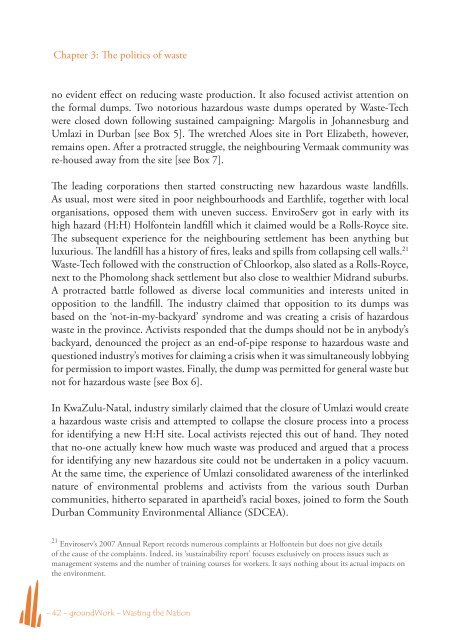Wasting the Nation.indd - Groundwork
Wasting the Nation.indd - Groundwork
Wasting the Nation.indd - Groundwork
Create successful ePaper yourself
Turn your PDF publications into a flip-book with our unique Google optimized e-Paper software.
Chapter 3: The politics of wasteno evident effect on reducing waste production. It also focused activist attention on<strong>the</strong> formal dumps. Two notorious hazardous waste dumps operated by Waste-Techwere closed down following sustained campaigning: Margolis in Johannesburg andUmlazi in Durban [see Box 5]. The wretched Aloes site in Port Elizabeth, however,remains open. After a protracted struggle, <strong>the</strong> neighbouring Vermaak community wasre-housed away from <strong>the</strong> site [see Box 7].The leading corporations <strong>the</strong>n started constructing new hazardous waste landfills.As usual, most were sited in poor neighbourhoods and Earthlife, toge<strong>the</strong>r with localorganisations, opposed <strong>the</strong>m with uneven success. EnviroServ got in early with itshigh hazard (H:H) Holfontein landfill which it claimed would be a Rolls-Royce site.The subsequent experience for <strong>the</strong> neighbouring settlement has been anything butluxurious. The landfill has a history of fires, leaks and spills from collapsing cell walls. 21Waste-Tech followed with <strong>the</strong> construction of Chloorkop, also slated as a Rolls-Royce,next to <strong>the</strong> Phomolong shack settlement but also close to wealthier Midrand suburbs.A protracted battle followed as diverse local communities and interests united inopposition to <strong>the</strong> landfill. The industry claimed that opposition to its dumps wasbased on <strong>the</strong> ‘not-in-my-backyard’ syndrome and was creating a crisis of hazardouswaste in <strong>the</strong> province. Activists responded that <strong>the</strong> dumps should not be in anybody’sbackyard, denounced <strong>the</strong> project as an end-of-pipe response to hazardous waste andquestioned industry’s motives for claiming a crisis when it was simultaneously lobbyingfor permission to import wastes. Finally, <strong>the</strong> dump was permitted for general waste butnot for hazardous waste [see Box 6].In KwaZulu-Natal, industry similarly claimed that <strong>the</strong> closure of Umlazi would createa hazardous waste crisis and attempted to collapse <strong>the</strong> closure process into a processfor identifying a new H:H site. Local activists rejected this out of hand. They notedthat no-one actually knew how much waste was produced and argued that a processfor identifying any new hazardous site could not be undertaken in a policy vacuum.At <strong>the</strong> same time, <strong>the</strong> experience of Umlazi consolidated awareness of <strong>the</strong> interlinkednature of environmental problems and activists from <strong>the</strong> various south Durbancommunities, hi<strong>the</strong>rto separated in apar<strong>the</strong>id’s racial boxes, joined to form <strong>the</strong> SouthDurban Community Environmental Alliance (SDCEA).21 Enviroserv’s 2007 Annual Report records numerous complaints at Holfontein but does not give detailsof <strong>the</strong> cause of <strong>the</strong> complaints. Indeed, its ‘sustainability report’ focuses exclusively on process issues such asmanagement systems and <strong>the</strong> number of training courses for workers. It says nothing about its actual impacts on<strong>the</strong> environment.- 42 - groundWork - <strong>Wasting</strong> <strong>the</strong> <strong>Nation</strong>
















